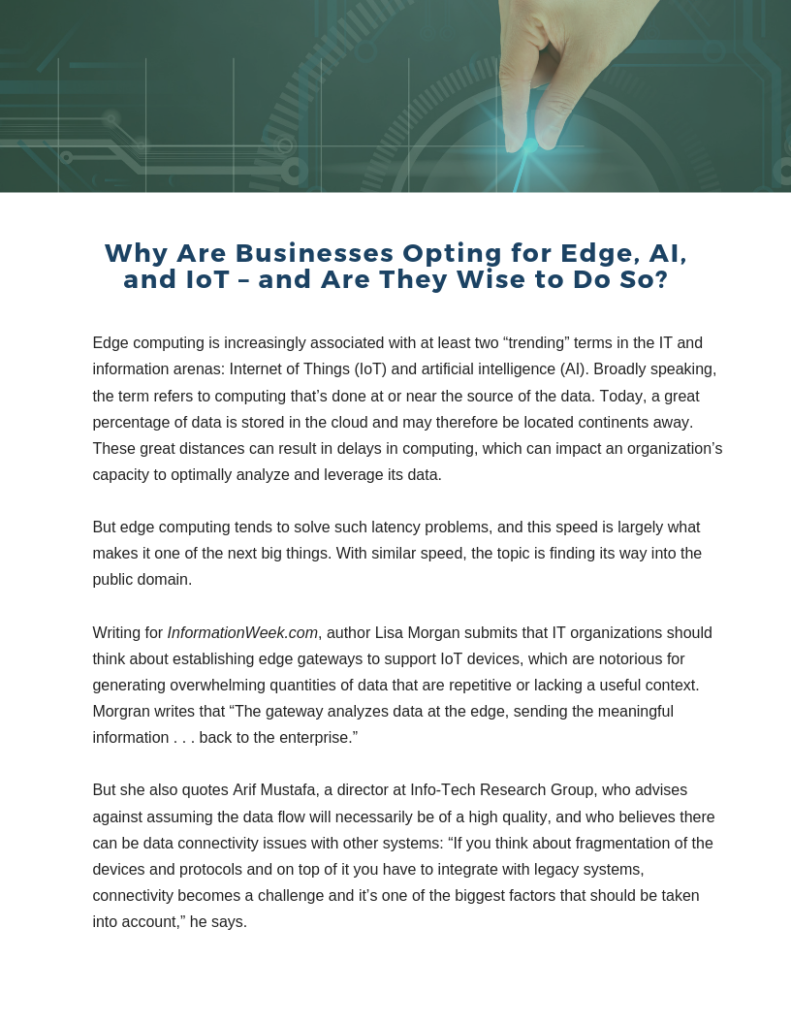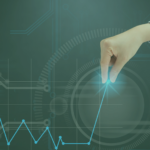Why Are Businesses Opting for Edge, AI, and IoT – and Are They Wise to Do So?

Edge computing is increasingly associated with at least two “trending” terms in the IT and information arenas: Internet of Things (IoT) and artificial intelligence (AI). Broadly speaking, the term refers to computing that’s done at or near the source of the data. Today, a great percentage of data is stored in the cloud and may therefore be located continents away. These great distances can result in delays in computing, which can impact an organization’s capacity to optimally analyze and leverage its data.
But edge computing tends to solve such latency problems, and this speed is largely what makes it one of the next big things. With similar speed, the topic is finding its way into the public domain.
Writing for InformationWeek.com, author Lisa Morgan submits that IT organizations should think about establishing edge gateways to support IoT devices, which are notorious for generating overwhelming quantities of data that are repetitive or lacking a useful context. Morgran writes that “The gateway analyzes data at the edge, sending the meaningful information . . . back to the enterprise.”
But she also quotes Arif Mustafa, a director at Info-Tech Research Group, who advises against assuming the data flow will necessarily be of a high quality, and who believes there can be data connectivity issues with other systems: “If you think about fragmentation of the devices and protocols and on top of it you have to integrate with legacy systems, connectivity becomes a challenge and it’s one of the biggest factors that should be taken into account,” he says.
Morgan’s article discusses associated business challenges that are all-too familiar, such as implementing these technologies before having a business strategy in place, for instance, and failing to consider the privacy and security requirements.
Said Mustafa: “When artificial intelligence and IoT merge, that makes security even more complicated.”
Teradata’s Bob McQueen tells Morgan that data governance should not be backed into. “The strategy should be preplanned and incrementally developed as you develop your smart data management approach.”
An item on HelpNetSecurity.com summarizes an industry study that suggests edge computing is on the rise in IoT deployments. The study, conducted by Strategy Analytics, indicates that data will be processed via edge computing in nearly six of ten IoT deployments by 2025, a trend that’s driven by more efficient use of the network, by security concerns, and by response time.
Andrew Brown, a Strategy Analytics executive, says the trend makes sense for businesses because “Taking a more efficient and optimized approach in terms of what data is sent to the cloud, with reductions in traffic volumes, has positive net effects both on the security of the data being sent and the cost of sending data to the cloud.”
SVP David Kerr of Strategy Analytics is careful to remind us of the challenges that remain, such as “immaturity of the current market and perceptions among customers that they have no need to change their current setup.”
John Koon, writing for SensorMag.com, aligns with the popular belief that the boost in edge computing is driven largely by the shifting focus from “collecting massive data to meaningful use of analytics.”
He provides a helpful illustration by suggesting that a smart thermostat may send its temperature readings every five seconds – useless, repetitive data that builds up fast and hogs the network bandwidth. “On the other hand,” writes Koon, “a sudden change of temperature from ambient to 400 ºF may indicate a fire or explosion nearby. Knowing when such a drastic change occurs constitutes ‘meaningful use.’” And with edge computing, the cloud servers won’t perform all of the processing, but sensors at the edge of the network will pitch in, thus resulting in quicker notification of such anomalies. “With edge computing, a smart thermostat will only send data to the cloud server if the readings exceed the temperature profile.”
Koon takes a wholly optimistic view of the teaming of AI and edge computing, citing the value of smart sensors, in particular: “Coupled with smart sensors, the edge domain will take over local decision making. This is particularly useful in building smart cities, performing cybersecurity duties, and carrying out many of the automated functions.”
As with any hot topic, information pros and governance stakeholders will continue to debate the benefits, risks, and challenges inherent in edge computing, a solution that might evolve too fast for definitive agreement on these benefits, risks, and challenges. For a fresh, detailed, and expert look at this and other cutting-edge topics, plan to attend ARMA InfoCon 2019 this October in Nashville. To see the schedule of events and sessions, visit the web page – and check back often for updates.

View the PDF version of this article
[ls_content_block id=”690″]
[ls_content_block id=”669″]
[ls_content_block id=”728″]
About the Author
 Communications2019.09.17Eisen’s Book on Rule-Writing Delivers on its ‘How-To’ Promises
Communications2019.09.17Eisen’s Book on Rule-Writing Delivers on its ‘How-To’ Promises Analytics2019.09.06Will Google Play Fair in the ‘Privacy Sandbox?’
Analytics2019.09.06Will Google Play Fair in the ‘Privacy Sandbox?’ Electronic Records Management2019.06.18Goals of New Canadian Digital Charter Include Assuring Privacy, Eradicating Hate Online
Electronic Records Management2019.06.18Goals of New Canadian Digital Charter Include Assuring Privacy, Eradicating Hate Online Analytics2019.06.11Why Are Businesses Opting for Edge, AI, and IoT – and Are They Wise to Do So?
Analytics2019.06.11Why Are Businesses Opting for Edge, AI, and IoT – and Are They Wise to Do So?